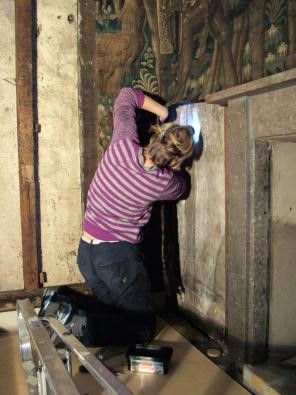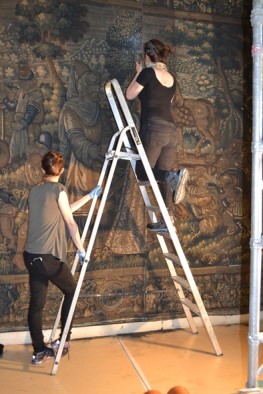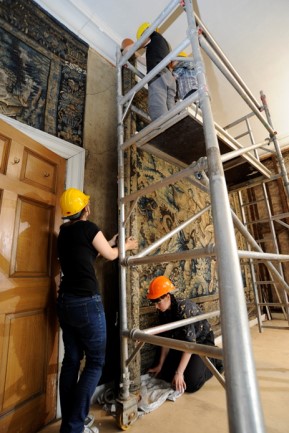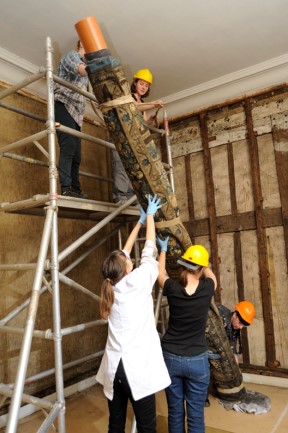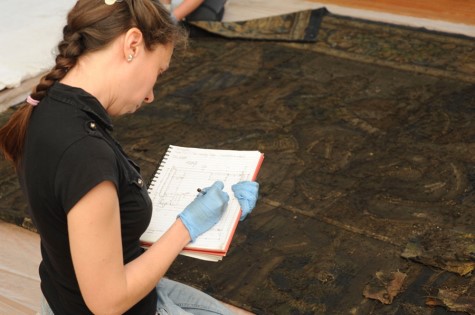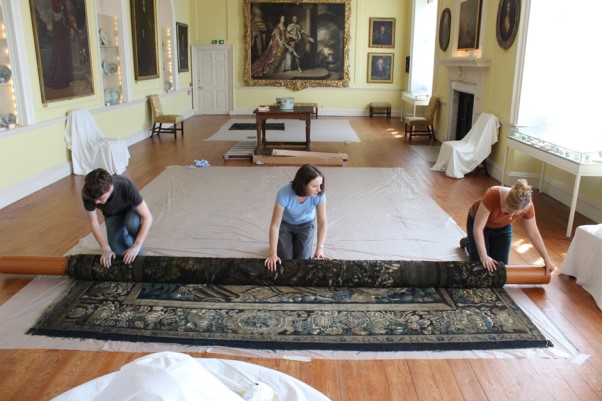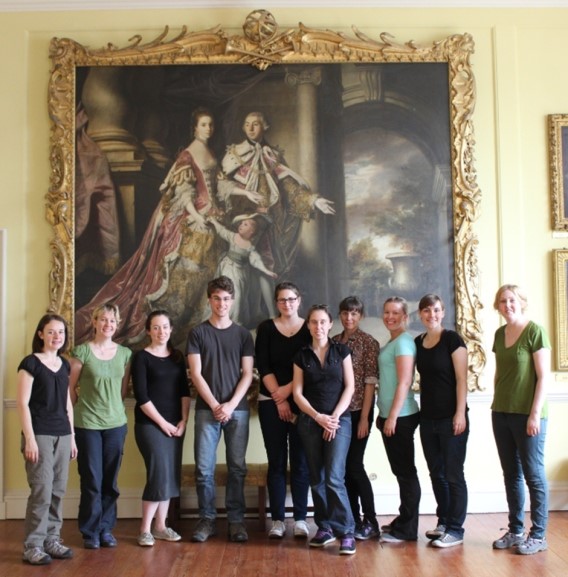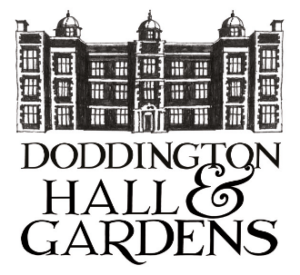In mid-June, the tapestry team were involved in de-installing a series of tapestries, dating from the mid-1600, in the Yellow Bedroom, at Doddington Hall. These tapestries are thought to depict scenes from the Trojan war. We were joined by a professional conservation practice WHConservation and five international students for the documentation and taking down of the tapestries.
The tapestries were used like wallpaper to decorate the Yellow Bedroom. There were nine separate panels joined to create the room scheme. Not all the panels were from the same tapestry set, and in some cases, it was visible that a complete tapestry had been cut into two parts and displayed on opposite walls. This was very intriguing for us to examine where each panel came from and to find out whether they were part of the same series or a completely different one.
Image 1. The South wall of the yellow bedroom before take down. You can see this wall has two separate tapestries butted up to each other to cover the wall.
The condition of the tapestries was quite poor. They exhibit damage caused by exposure to light, coal fires, and dust and pest infestation over the past 400 years. This has caused colours to fade, holes/ loss of wool/and silk, and heavy soiling from soot and dust.
It was a nine-day project onsite at Doddington Hall over a three-week period and we were managed by Elaine Owers our tapestry expert. The whole team was split into two groups to have an efficient takedown, rotating the teams round, so everyone gained work experience in each part of the tapestry takedown process.
One group was based in the Yellow bedroom (which is in the private apartments of the hall), and were given the task of removing the original hanging method (iron tacks/nails) that were used to hang the tapestries in the 1700’s. The team started with the tacks along the bottom and side edges to release the tapestry, leaving the top edge still intact. This was very dirty work, we all resembled sooty chimney sweeps by the end of each day! A scaffold tower and ladders were used for this, when it was impossible to reach the nails from floor level.
Image 2 and 3. Conservators in action, removing tacks from the Yellow Bedroom Tapestries
We pinned a strip of prepared Velcro along the reverse side edge of the tapestry and attached it to a drainage pipe with the corresponding piece of Velcro. Once the tapestry was attached, we began to remove each nail along the top edge, rolling the tapestry as we went. It was a slow process, but it was the safest way to take down the tapestries. Once fully rolled, the tapestry was secured with Velcro straps and was then lowered to a team to transport to the Long Gallery (in the main apartments at Doddington Hall) where the tapestry would be examined, documented and surface cleaned.
Image 4 and 5. The team removed the tapestry from the wall. Once rolled the tapestry was lowered to a team to transport to the Long Gallery
Group two, who were based in the Long Gallery, were firstly tasked with preparing the room for the tapestries, covering the original wooden floors with large polythene sheets and setting up any equipment that was needed. Once the room was prepared, the tapestries were unrolled and examined from the reverse. We were looking for any previous repairs (patches), insect infestation, damage and folds. Each tapestry was measured accurately for future reference, as the owners of Doddington Hall would like the tapestries once conserved to be returned to the walls in the same layout as they had been hanging for the last 250 years.
Image 6. Leah, a conservator from WH Conservation carrying out documentation
Once the documentation was complete on the reverse, we began to surface clean using specialist low suction vacuum cleaners. We worked from one side to the other, rolling the tapestry as we went. Each section cleaned was approximately 50cm and was carried out by four people for 8 minutes. The team worked their vacuum brushes in both vertical and horizontal directions to remove as much dirt as possible, this was very hard hot work! Once the reverse side was surface cleaned, the process was repeated for the obverse face of the tapestry. The only difference was the surface cleaning was shortened to 6 minutes (this was discussed with the team) because the reverse face of the tapestries usually collects more dust, as tapestries act as a filter drawing dust and dirt through them.
Image 7. The international students carrying out surface cleaning on the reverse of one of the tapestries
After documentation and surface cleaning all the tapestries were packed ready for transport to Belgium to be wet cleaned. The tapestries were rolled face out onto drainage pipes with acid free tissue interleaved in a series of long sheets to keep the tapestry clean. A layer of breathable water proof Tyvek fabric was then wrapped around each rolled tapestry and secured with Velcro straps. A final layer of bubble wrap was applied and a label identifying each tapestry, they were now ready for their travels.
Image 8. The team preparing a tapestry to be carefully wrapped from transportation
Throughout all of these stages, each task was documented by SLR digital photography, and short videos of the processes.
We really enjoyed our time at Doddington Hall and as none of us in the tapestry team were involved with the take down of the Holly bedroom tapestries back in 2010 it was great to see and be involved in the process this time around. It really gave us an idea of just how dirty the Holly bedroom tapestries must have been before they were cleaned and we are all excited to see the results of the wet cleaning of these Yellow bedroom tapestries. The opportunity to share our textile conservation knowledge with the international students as well gave us great satisfaction.
The next stage for the tapestries from the Yellow Bedroom will be to be couriered to a specialist facility in Belgium called “De Witt”, where they will be expertly wet cleaned. The tapestry team are very fortunate to be joining the tapestries in Belgium very soon, so please read our future blogs to find out more about our experiences.
Image 9. After the all the tapestries were taken down and carefully packed for transport, we managed to have a group photo in front of a Reynolds painting
For images and weekly updates on the conservation project, follow us on Instagram at conservation_at_doddington.


